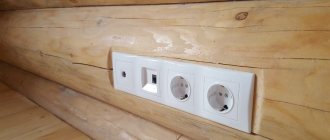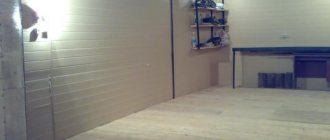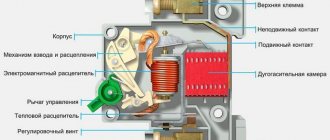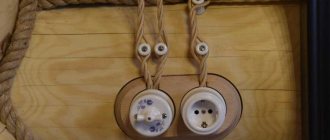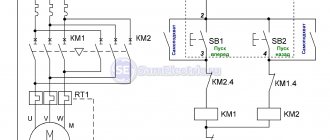Checklist of electrical network elements
This is the first article in which I will tell you my ideas for installing electrical wiring. I am planning a continuation, where I will tell you about the implementation of ideas, right up to the finished installation. I don’t presume to say exactly how many articles there will be. I'll try to make do with available resources. I'll tell you about interesting resources and techniques.
The moment has come when you realize that the current state of the wiring in the house does not suit you. About 40 years have passed since the construction of the dacha. Requests have grown. I didn’t want maximum comfort (there is no limit here), but I wanted the house to be comfortable and in good working order.
Backup power sources
An important aspect that requires attention is power outages. For the owner of a country house, any interruption can cause serious inconvenience. An independent power source will allow you to solve this problem in advance. It is most advisable to use electric generators (Fig. a ), gasoline or diesel, as well as the increasingly popular solar panels (Fig. b ) and wind generators (Fig. c ).
Types of independent power supplies:
- a — fuel generator;
- b - solar panels;
- c - wind generator.
The choice of fuel generator type depends on the intensity of its use. Diesel engines are designed for long-term operation; their operating costs are an order of magnitude lower than the operating costs of gasoline engines. The latter are much cheaper.
For optimal operation of fuel generators, it is recommended that their power be 20–30% higher than the total power of simultaneously turned on electrical appliances powered from it. In practice, a 2 kW generator is sufficient to illuminate a small house and run a refrigerator.
As for solar panels and wind generators, their use is expected not only during power outages, but also as a constant source of power in order to save money on maintaining the house. Such systems are especially popular in so-called green houses, where technologies that do not pollute the environment have been introduced.
Analyzing electrical problems
When planning the work, we carefully write down our wishes and form a rough plan.
To do everything at once and never come back, I suggest going through the checklist.
First of all, we pay attention to what our safety depends on. These are critical faults that require repair. No, you can’t put it off until “later.”
– inspect the electrical panel for terminal oxidation, mechanical damage, traces of rodents and insects. Were there any strange malfunctions or sudden automatic shutdowns of the machines? We write everything down.
– inspect all junction boxes (open the lid and examine the filling) and input into the house (facade of the building, connection to the meter) for oxidation, overheating and improper installation;
– faulty lamps, switches, sockets and other electrical installation and installation products. Was there a smell of burnt plastic? Or maybe there were sparks when you pulled the plug out of the socket? Does the light bulb in the chandelier blink if it is accidentally touched? The switch key does not immediately move to the “on” or “off” position?;
– obsolete sockets (old Soviet ones, it’s difficult to plug in a European standard plug);
– for open wiring – inspect the appearance of the network for mechanical damage (for example, you put a table leg on the wire. Don’t laugh, anything can happen), insulation or its degradation (for example, from ultraviolet radiation). If the veins are already visible, urgent repairs are needed;
– determine the cross-section of the cable used to enter the house (if each core is 2.5 mm2, this is already too small according to modern requirements);
– there is household equipment that requires a separate powerful line with its own circuit breaker (for example, a washing machine or a powerful power tool). I classify this item as a critical malfunction, because operating equipment that is turned on “anyhow” can lead to a fire.
You can add to the list yourself, based on the “filling” of your home.
Preparing the circuit
To conduct electricity in the country, they draw up a diagram. There are 2 options:
- standard - the diagram is drawn on paper, the drawing should be approximate, so everyone can do it;
- modern - they use special programs.
The work is quite simple. They depict an approximate plan of the house and indicate on the diagram the installation points of sockets, switches, lamps, junction boxes, and equipment that also consumes electricity. It is advisable to indicate the location and number of cables here.
The wiring diagram makes it easier to calculate loads.
- The load from all consumers is summed up: lamps, fan, electric kettle.
- They are divided into groups : 1 connection for a washing machine, 2 for a group of lamps in the room. 3 – for the second group, 4 – for the module with sockets. This reduces the number of wires and avoids current overloads.
- Calculate consumer power - total and for each line. Based on these data, the parameters of electrical engineering are determined.
For calculations, product passports or reference data will be required.
Convenience and comfort
Next we look at it from an ergonomic point of view.
Items from this list do not apply to critical faults requiring urgent repairs: – places with insufficient lighting;
When thinking about a future project, keep in mind that one light bulb per room is usually not enough (unless it is a toilet or bathroom). Any lighting must have its own working scenario. Installing backlighting simply because you want to is short-sighted (you won’t use it anyway, but money and time have already been spent). In terms of ergonomics and lighting, I highly recommend the site houzz.ru, Articles section. There is no separate section for electrical work, so you will have to search.
– switches located in inconvenient places;
– inconveniently located sockets (the website houzz.ru also has about sockets) or insufficient number of sockets (you have to use a tee);
– Do you often use power tools outdoors? Is the extension cord that is pulled from the outlet in the house getting in the way? Install an outdoor waterproof outlet that is switched off by a separate circuit breaker. Please note that on some models, the covers that cover the sockets no longer stay in place over time. Choose a place for an outdoor outlet that will be 100% protected from precipitation, and even better, from the sun. Electrical insulating materials are either non-flammable or UV resistant.
– think about options for the future: perhaps the house needs a separate line for an electric stove, hood, refrigerator, heater, pump or boiler.
Even if you don’t see the point now, leave free space when designing the electrical panel (for circuit breakers, voltage stabilizers, terminal blocks and automation), the input cable should also be selected with a reserve cross-section;
What kind of wiring should be done - hidden or open?
The advantages of hidden wiring are obvious. All wires and electrical fittings (socket boxes, distribution boxes) are hidden from view in grooves and sockets made in building structures and “camouflaged” with finishing, and only decorative frames remain outside. But this solution also has its downsides. If it is necessary to move, for example, an outlet to a more convenient location, you will need to dismantle the finishing, lay a new channel, reinstall the fittings and carefully hide all “traces of interference.” In addition, if the house is wooden, you will need to ensure that the wiring meets increased safety requirements. In the case of open wiring, their presence in the interior will have to be played up using various design techniques, but any “relocation” of the same outlet will not cause any problems.
Current state of the electrical system in the house
At the moment, the electrical network in my house requires upgrading. I'll tell you more.
We have a country house of the “dacha” type, not intended for living in winter. Half of the first floor is brick, the veranda (kitchen) and the second floor are wooden. This imposes the first and main limitation on the choice of materials and installation - non-flammability. In addition, the house is humid in winter. I don’t yet know how I will ensure the resistance of the electrical network to moisture in the air. For now I’ll just remember this as a fact.
The wiring is morally and physically outdated (there is not enough lighting, there are few sockets and are inconveniently located, all connections are made with long twists, twists of stranded and single-core wires were found, places of corrosion and overheating were found, there was not enough cross-section), the installation was carried out with wires of the type “whatever we could get.”
There is no grounding and never has been. Yes this is bad. Taking into account the fact that more than half of the network in the house has already been updated and does not require urgent intervention, it is possible that I will not do grounding.
1. The entry into the house with an aluminum cable was done poorly! In blue insulation - copper cable 2x1.5.
Additionally, the entry into the house (photo 1) was done incorrectly: the connection between the SIP (aluminum) and the wire into the house (type unknown, conductors - copper) was made by twisting (twisting is very conditional in this case). This was discovered completely by accident. It stood in this form for about 5 years from the moment it was installed by a local gardening electrician. It's simply not visible from ground level.
Let me further explain: the craftsmen did not stand over the soul during the work, did not check afterward, and paid the amount he announced without haggling.
Instead of one 2x2.5mm2 wire, two pairs of 2x1.5mm2 wires are laid. The section is no longer enough, the veins have oxidized. In addition, one end of the wire is open to all winds and rain. The capillary effect did its dirty work and one day the machines began to break out “just like that”* (*Nothing happens just like that). After replacing them, it turned out that the input terminals, along with the filling, were completely oxidized. There is nowhere else for water to come from. The roof is intact, there are no leaks. And high humidity would have oxidized all the terminals on the machines, but they were absolutely clean.
The networks of sockets and lighting are not separated; they are turned on by one common machine.
Important conditions for conducting electricity to a site in a village
When drawing up a plan for the electrification of a country house, the volume and type of work is determined. For example, this could be laying a new line or reconstructing an existing one.
In all cases, the following rules are observed:
- Electrical panels, metering devices, distribution boxes and other system elements must be located in accessible places.
- Switches must be mounted so that they are not blocked by the opening door leaf. The elements are placed at a height of 80-150 cm.
- There must be a distance of at least 50 cm between sockets and water supply, heating devices and gas pipes.
- Power cables to sockets are pulled from bottom to top. When connecting switches, work is carried out in the opposite direction.
- Do not directly connect aluminum and copper conductors.
- It is not advisable to install sockets in rooms with high humidity.
- The drawing according to which the wiring is laid must be saved.
Power output
In domestic conditions, lines up to 15 kW are installed. The released power does not depend on the area of the site and the buildings located on it. A limit is also set on energy consumption - 3-5 kW per hour. This prevents multiple powerful devices from being turned on at the same time. When the devices are started one after the other, the limitation does not affect the operation of the electrical network.
Garden electrical equipment
Here I think it is necessary to move away from the topic to explain one thing.
The contract for the supply of electricity for gardening specifies a markup for losses in networks - 2.4% (the figure may be different in different gardens).
Where does this figure come from? This particular meaning seems to come from the ceiling.
In fact, this is the difference between the total gardening counter and the sum of all readings from each gardening house. The difference is mainly formed due to non-payers and those who steal electricity. This also includes electricity losses due to heating of the wire. Where does the heating come from? Any whole wire has a certain resistance. The current passing through the wire, overcoming resistance, does work, causing the wire to heat up. The greater the load (current electricity consumption), the greater the heating. At a length of a couple of meters it does not particularly affect the readings. What if the wire is 500 meters long?
If the wire connections are made poorly (see photo above), they have even greater resistance than a whole wire. They also get hot and waste energy to heat up. It’s as if a small light bulb has been on all day long. If the contact is bad, the same thing will happen:
2. The glow of such a “light bulb” indicates a high current and poor contact
In the most extreme case, the heat is so intense that it causes a fire. Touch the cord, plug of the electric kettle and the socket in which it is plugged in after it boils. Warm? There it is. The socket is weak and requires replacement, or was not originally designed for a powerful load. You can roughly estimate how many such connections there are for a garden of 100 plots. A significant amount of electricity is wasted throughout the year.
Country electrical installation: basic electrical safety
If you assemble the electrical wiring diagram for your dacha yourself, you should take care of your personal safety yourself. Before starting installation operations you should:
- de-energize the work area, make sure that accidental power supply is excluded;
- check screwdrivers and pliers for quality of insulation of handles;
- wear shoes with rubber soles;
- make sure that there are no water spills in the work area;
- Using indicator and measuring electrical devices, make sure there is no voltage.
Having finished assembling the wiring diagram on your own, it makes sense to invite a professional electrician for additional control. It will measure the grounding and insulation resistance and help verify the correctness, quality and safety of the assembled electrical network.
What will we change?
Let's return to the topic and go through the “wishlist”.
Purchased an induction cooker. It has increased connection requirements. The voltage in the dacha network is usually low, which can lead to breakage of the stove. At the moment it is simply plugged into the outlet, but in the future you need to run a separate wire and provide a voltage stabilizer.
The refrigerator is old, but working. There are situations when you need to leave it on and leave for a couple of days. It is unsafe to leave the entire network turned on, so the refrigerator needs its own wire with a circuit breaker.
There is a light bulb in the corridor that illuminates the stairs to the second floor. If it is turned off, it is dark to rise. The solution is to install a pass-through switch. Why not a motion sensor? one sensor will not be able to cover the entire space, and if you install two (one per floor, near the stairs), then there will be no clear command to turn on (simply being at the top, without having the desire to go down, I will turn on the light bulb below). LED staircase lighting? Option. But there is already a light bulb that does this. The LED backlight still needs to be turned on somehow. Reason – see above.
I would like to make a sink and drain for the kitchen. I am planning to install a water tank in the house. This entails the installation of automation for the pump (there is a well), and you will also need a second street outlet for the pump itself (which will be controlled automatically).
Lighting in the kitchen. More LEDs to the God of LEDs (don’t forget, each backlight has its own scenario)!
Important! If your home has (or is planned to) other household equipment, find out the requirements for its connection, installation and operation. For example, is it possible to place an oven next to a refrigerator (and how close can they be), will they withstand winter in an unheated house, is a voltage stabilizer needed, and what size wire is needed for connection. Etc. and so on. Typically, these requirements are described in the operating instructions.
Well, that seems to be it. It is possible that more ideas will arise during the design process. We draw a diagram, look at SNiPs, leaf through catalogs.
When do you need a power supply system with a voltage of 220 V, and when 380 V?
When solving this issue, it is necessary to take into account the area of the building and what electrical equipment it contains (stove, boiler, boiler, pump, etc.). For a house less than 120 m², as a rule, a single-phase voltage of 220 V is sufficient, since the vast majority of consumers in private homes are single-phase, with a power consumption of less than 10 kW. If we are talking about an impressively sized mansion or the house has devices with three-phase power (say, an electric motor), then a linear voltage of 380 V will be required, that is, a three-phase input. It is worth keeping in mind that due to the high electrical hazard, it will be more difficult to obtain permission to connect to a 380 V network, but it will be possible to use electricity more economically and even get more allocated power.
5
New entrance to the house
The hardest thing is to start. Therefore, let's start with the simplest and most understandable at the moment. Entering the house.
First, let's take a look at the requirements.
The facade fastening of the wire must be located at a height of at least 2.5 m from the ground and at least 0.3 m above the window. From the side of the window to the wire there should be at least 0.5 m, from the doorway to the wire - at least 1 m. Between the points of attachment to the facade - 0.7 m. You can do less, but if you do more, the wire will sag.
Let's decide on the materials.
A SIP type wire approaches the facade of the house, where a VVG NG 2x6mm2 cable is routed to ceramic insulators. The SIP is attached to the facade using a tensioner (search for the phrase “anchor clamp for SIP wire”).
The insulation of the SIP wire is resistant to ultraviolet radiation, but is flammable. Therefore, the wire can be attached to the facade (necessarily at a distance), but cannot be led into the house.
The insulation of the VVG NG wire is non-flammable, but not resistant to ultraviolet radiation. Therefore, we will hide the wire in black corrugation, it will protect it from the sun. The edge of the corrugation will go into a metal pipe, which will allow the wire to pass through the wall. We remember that the wall is wooden, which means it is flammable. The only way through such a wall is through a metal pipe.
Photo 3 – entry into the pipe. Please note that a loop is formed in front of the pipe - so that trapped moisture does not flow into the house.
From the room side, the input looks like this:
4. Entry into the house from the premises
In theory, you need to fill the space between the walls of the pipe and the wire with non-flammable filler. I still had a thick basalt fiber cord left after installing the stove. I'll unravel it and use it.
Basalt cord is non-flammable for stoves. Picture from the site kuzmich24.ru
On the street we use only black corrugation. Why? Yes, that's why:
This is how gray corrugation decomposes under the influence of sunlight
This is just the beginning. Soon only separate pieces will remain of it.
What the introductory electrical panel looks like now, it needs to be completely redesigned:
Electrical panel in a country house with 25, 25 and 16 A circuit breakers
VVG NG 2x6mm2 in the area of the meter is connected to old 2x1.5 cables, which, if you look closely, can be seen at the meter inputs. From the meter, the phase and zero wires go to 2 25 A machines, then to the house. And the street socket, which I will talk about later, is powered through a 16 A circuit breaker. I know that there are many, many mistakes in this panel, but the country electrician did this, and he is an indisputable authority among us...
Security
Electricity in a dacha requires compliance with the same safety measures as in a multi-storey building. To prevent emergency situations and electric shock, it is necessary to use RCDs, circuit breakers and grounding.
Grounding
For servicing holiday villages, a cable was most often used in which the neutral and grounding were combined. When it breaks, voltage accumulates on the housings of electrical appliances, which is dangerous. Therefore, the owner of the dacha needs to install the grounding circuit . It is a metal isosceles triangle , at the ends of which electrodes are fixed. The height of the electrode is from 2 to 3 m, the length of the side of the triangle is from 1 to 3 m. A steel corner of 50 * 50 mm with a steel thickness of at least 4 mm is used as an electrode. For the “side” of the triangle, take a strip of 40 * 4 mm.
The structure is buried in the ground at a distance of no closer than 1 m and no further than 10 m. A grounding wire coming from the junction box is connected to the electrode closest to the house.
Protective automation
To protect the electrical network from overloads, and equipment from short circuits and insulation burnout, protective devices are used.
Circuit breakers are mounted on each consumer group separately. When the set voltage or current is exceeded, the module turns off the serviced circuit. After normal current supply is restored, it turns on.
RCD is a protective module that responds to leakage currents that occur when insulation is damaged or when the neutral wire is broken. The RCD cuts off the current supply to the consumer and thereby prevents a fire in the broken area.
How the new input cable was laid
Mark the wire attachment points directly on the wall. We drill holes and install fasteners. They will allow you to maintain a distance between the wall and the wire. The fastening is searched for using the phrase “facade fastening for wire.”
Corrugated cable fastenings along the facade
The screed is usually included in the kit.
Cable mounts are mounted under the canopy along the facade of the house
To be honest, we managed to meet only one height requirement – at least 2.5 m from the ground.
Gander for fastening SIP and input cable, there will also be a connection point
After installation is complete it looks like this:
New entrance to the house: SIP and corrugated cable on a gander
I don’t know how it is now, but before this mount was called a “gander.” Here is my old article on how I connected the wire from the street line and the input cable to the gander.
We are done with this stage.
Introduction
As a rule, the most difficulties arise precisely at this stage of arranging a country house.
Perhaps the main problem is the cost of connecting to power grids and coordinating project documentation and permits. Be prepared to deal with a lot of paperwork.
First of all, you need to obtain technical specifications (TU) for power supply. Specifications contain information about the allocated electrical power, the procedure for performing work on power supply to the house. They also list the requirements:
- strictly implement the project and coordinate its possible changes with the territorial body of Gosenergonadzor;
- carry out installation work with the involvement of organizations that have the appropriate licenses;
- carry out tests of the power supply system.
If all the conditions specified in the technical specifications are met, after the installation of the power supply is completed, a commissioning certificate is drawn up, which is endorsed by the State Energy Supervision inspector. The validity period of the technical specifications is limited, as a rule, to one year. If this period has expired and the electrical equipment is not connected, you will have to obtain a new set of documents.
The next step is to find a contractor who will develop a project for powering the house. The ideal option is when the power supply project and installation work are carried out by one organization.
The result of the work is obtaining a certificate of approval of energy supply systems for operation. Additionally, approvals may be required from Gosenergosbyt, an organization that deals with energy consumption accounting and settlements with consumers.
As a result, the developer must collect a set of the following documents:
- agreement for the provision of services and performance of work between the developer and the contractor;
- power supply project agreed with Gosenergonadzor;
- test reports of electrical equipment and wiring by a certified laboratory;
- act of performing electrical installation work by an organization that has the appropriate license;
- electricity supply agreement between the electricity consumer and Gosenergosbyt;
- certificate of admission to operation of an electrical installation, endorsed by an inspector of the State Energy Supervision Authority.
Even before receiving the specifications, the owner of a country house must calculate how much electricity he needs, based on the number and power of electrical appliances. The average power consumption values of some electrical appliances are shown in the table below.
Average values of total power consumption of some electrical appliances
Don't forget to take into account the power consumption of the lamps. Typically, such devices use incandescent lamps with a power of 60–100 W, but they can be replaced with more modern energy-efficient lamps (25–35 W). The illumination will remain the same.
Installation of sockets
Street outlet. Included via a separate machine. It has been in use for 3 years now, no complaints. Wire VVG NG 2x2.5 mm2. The lid was closed only for the first month or two. Then I had to put on a rubber band.
Outdoor socket with covers and rubber band)
Entry into the socket body must be from below.
The passage of the wire through the wall is through a metal tube. From the street side, the difference in diameters is leveled out by heat shrinkage; a loop of wire is required to drain moisture.
Passing a cable through a wall using a metal pipe
You need to clarify about installation on flammable surfaces. Sockets must have a metal base (such are commercially available) or a non-flammable socket box. The wire must not be attached directly to the wall. The ideal option is ceramic insulators.
In the case of an outdoor outlet, I should add a metal plate. It should be of such a size that it protrudes beyond the dimensions of the socket body by several millimeters. Metal plate under the socket:
External socket on a non-flammable metal base
The same thing applies to switches.
Power supply project
All features of the planned power supply system for a country house must be reflected in the project. A home power supply project should consist of text and graphic parts.
The text part contains:
- characteristics of power supply sources in accordance with the specifications for connecting the facility to public power supply networks;
- justification of the adopted power supply scheme;
- information on the number of electrical receivers, their power;
- requirements for reliability of power supply and quality of electricity;
- description of solutions for providing electricity;
- list of measures to save energy;
- list of grounding measures;
- information about the type of wires and lighting fixtures.
The graphic part includes:
- schematic diagrams of power supply and lighting networks;
- grounding (grounding) and lightning protection schemes;
- Electrical network plans, including light fixture installation plans and socket installation plans;
- single line diagram;
- specifications of materials and equipment.
Lamp installation plan
Socket installation plan
Single line diagram
Future plans
That's all for now. The whole winter is ahead for designing the circuit and electrical panel.
I want to talk about design. IEK has information for designers in its catalog (I don’t know about other manufacturers, for example, I didn’t find this from Schneider Electric or ABB). These are files in dwg (AutoCad) and step (Unigraphics) formats. This makes development very easy.
Design by IEK
Unfortunately, not every catalog item has such a rich set of files, but you can always find something very close in size. Some manufacturers even have proprietary programs for designing shields.
That's all for now. We wish Lena good luck! The most interesting things are yet to come!
I remind you that the article is competitive and takes part in voting. To find out how things are going with the Competition right now, follow the link.
Construction of lighting networks
The main modern element of lighting is electric lamps. This could be a large chandelier in the living room and dining room, a sconce on the stairs, a portable night light in the nursery, a floor lamp near your favorite chair and many other home lighting elements.
The following types of lamps are distinguished:
- external and internal - depending on the location;
- ceiling, wall, floor - according to the degree of illumination;
- overhead and built-in - according to the method of fastening;
- stationary and portable - according to mobility.
It is worth choosing the option that best meets the functional requirements and aesthetic preferences. For example, dust and moisture-proof lamps are recommended for wet rooms.
Wall-mounted dust and waterproof lamp
External lamps are installed at the entrance to illuminate it at night. Internal ones are located in all rooms of the house. Regulations allow not installing electric lighting in unused attics. Lamps in the house are divided into separate groups in accordance with the location of electrical cables and switching modes.
Street light
All electrical equipment of the house is powered from the electrical distribution panel - a device designed to service electrical networks. The main electrical panel is installed at the entrance of electricity into the house; it receives and distributes electricity in the building. It includes meters, RCDs (residual current devices), circuit breakers and other emergency equipment.
Modern electricity meter
Meters are designed to account for electricity supplied to consumers.
The RCD also ensures that the electrical load is disconnected under conditions that are dangerous for the user or the operation of the system. The residual current device prevents electric shock and an accident that can be caused by current leakage through poor-quality connections. It should be noted that this is a high-speed protective switch that responds to differential current in the electrical conductors to the protected electrical installation. The main functional blocks of the RCD are shown in the figure below.
RCD diagram
The residual current device in the distribution board can be installed both on the ground floor and floor by floor.
Installation of floor distribution boards and RCDs
Floor panels are designed to distribute energy on individual floors of a building and provide the possibility of their separate operation. This arrangement option is relevant if several families live in the house and run an independent household.
Batteries for autonomous systems
The principle of operation of the battery is clear and simple. As long as there is electricity in the central network, the batteries are charged from the outlet and accumulate resource in their blocks. Solar batteries function in a similar way.
When energy supplies are interrupted, the modules, through a special inverter installation, supply electricity to household appliances and various home systems.
When choosing a battery to create a backup electrical system in a residential building, it is worth determining which devices and modules of household appliances must be connected in the event of a lack of light. By adding together their base power, you can get a number indicating the capacity of the battery, capable of powering the most necessary devices
They are not suitable for constantly providing a living space with electricity, but they will cope with the role of a backup complex perfectly.
The following article, which is entirely devoted to this interesting issue, will introduce you to the best developments for organizing alternative energy in a country house.

